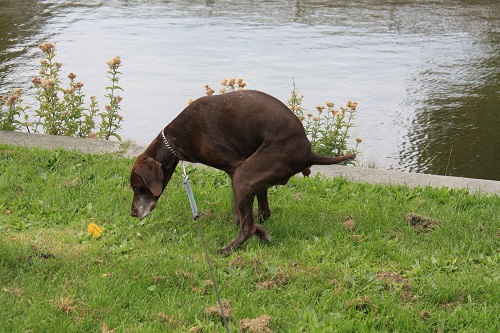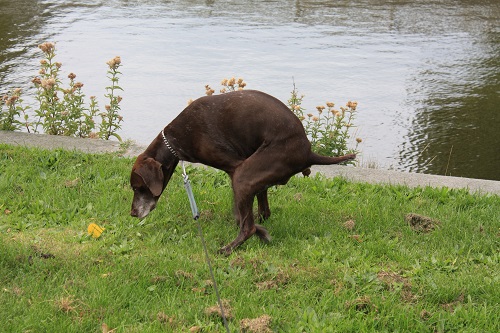 Ever notice your dog or cat in a hunched-up position either in the garden or in their sandbox and just not being able to “come right” with passing whatever it is they want to pass? In cats and female dogs, the posture of the animal when passing stool and passing urine is the same. It is therefore important to try and establish whether they are battling to pass a stool or alternatively if they are struggling to urinate. Both conditions may require veterinary attention and if the animal repeatedly hunches and strains with no apparent relief, it may be a sign that they need to see the vet.
Ever notice your dog or cat in a hunched-up position either in the garden or in their sandbox and just not being able to “come right” with passing whatever it is they want to pass? In cats and female dogs, the posture of the animal when passing stool and passing urine is the same. It is therefore important to try and establish whether they are battling to pass a stool or alternatively if they are struggling to urinate. Both conditions may require veterinary attention and if the animal repeatedly hunches and strains with no apparent relief, it may be a sign that they need to see the vet.
Male cats are prone to an obstruction of the ureter which will cause this kind of repeated behaviour and if left unattended, can lead to death.
In this article, we will be looking more closely at constipation. Constipation is the absence of passing stool or struggling to pass stool regularly. This is not a disease in itself, but a cause of other disease processes, leading to constipation. It is always important to seek medical advice for this reason, as it is important to find the cause of constipation to be able to treat it correctly.
If solid waste stays in your pet’s colon for too long, the moisture gets absorbed by the gut and it leaves hard dry stool that is difficult to pass. It is commonly found in dogs and especially cats. The clinical signs to look out for are the following:
- Listlessness
- Anorexia (loss of appetite and not wanting to eat)
- Vomiting
- Straining in a hunched position
- Arched back
- Bloating and abdominal pain
- Howling when trying to pass a stool
Seeing your animal in a hunched position, struggling to pass stool, or passing small hard balls of stool gives you a good indication that your animal might be constipated. Often animals can have diarrhoea, which is on the opposite of the spectrum to constipation where the animal has a loose or watery stool, and strain due to an irritated bowel, giving the owner the impression that they are constipated. Constipation can be acute or chronic. Chronic constipation can stretch the wall of the colon so much that it affects the movement of the colon permanently, leading to a condition called megacolon. This is often irreversible and can have a major impact on the animal’s quality of life. The causes of constipation can range from something as simple as insufficient fibre intake to more serious causes like tumours causing obstruction in the colon. By bringing your pet to the vet for a quick check-up, constipation can be confirmed relatively easily. If your animal is constipated, remembering that constipation is not a disease in itself but rather a symptom of the disease, the vet will then continue to look for the cause of constipation. This might require more advanced diagnostic procedures like blood tests and radiographs. Let’s discuss a couple of causes of constipation:
Diet and water intake
This is the most common reason for constipation, and the easiest to fix as well. A shortage of dietary fibre can lead to constipation. Fibre adds bulk to the stool and causes the colon to increase its movement. On the other hand, too much fibre can give stool too much bulk and also lead to constipation. In these cases, an easily digestible diet will solve the problem.
Water intake is very important, especially in cats. Water intake can sometimes be too low when cats are on dry food only and adding wet food adds extra moisture to the diet.
Foreign material
Material like hair, sand, rocks, plant material or bones can dry out and form a mass in the large intestines, leading to obstruction and constipation.
Obstruction
Any mass in the colon or around the anus can cause an obstruction if it is big enough. Anything that decreases the space through the pelvic canal can push into the colon, causing constipation, for example, The prostate gland in intact male dogs can become diseased, increase in size and push onto the colon. These patients often find it hard and painful to pass stool. In small pets, any pelvic fracture that heals with scar tissue formation, can lead to a decrease in the pelvic canal diameter and cause constipation. Anal or perineal (the area next to the anus) masses and anal gland abscesses can also obstruct the rectum and anus enough to cause constipation.
Pain
To pass a stool, dogs and cats go into a hunched position with their backs and hips. In animals with chronic pain in the back or hips, this pain may prevent them from going into this hunched position. Old, large breed dogs often suffer from hip dysplasia and severe arthritis, leading to constipation due to pain. The severe pain from arthritis makes passing stool a painful process for these animals which lead to them retaining a stool rather than going when nature calls. The stool retained in the colon becomes dry and increases in size and as a result of this, they can become constipated. Anal gland problems, like anal gland abscesses, may be so painful that the animal does not want to pass a stool.
Environment
Some animals will not pass a stool if not left alone quietly, or if they are not on grass. Pets that are staying at boarding facilities can often struggle with this problem. If exercise is reduced and they are kept in cages for long periods of time, bowel movements are slowed down tremendously. The stress and change of food can contribute to the problem. Cats can also get an aversion to their litter boxes, either to the location, litter type or cleanliness. They then retain their faecal mass until it leads to constipation. It is important to vary the litter type you use and make sure there are enough litter boxes in different areas of the house. Litter boxes need to be cleaned out daily.
These are a few of the many causes of constipation. It is important to realise that the cause has to be discovered first before treatment can be instituted. After the cause of constipation is resolved, treatment of the actual constipation is usually easily achieved depending on severity. This can vary from a change of diet and over the counter products to soften stool, to multiple enemas and faecal manipulation on awake animals, or in severe cases under anaesthesia. An enema is a usual treatment for constipation, and this can be done with warm water, lubrication material or soapy water. Never give your dog an enema at home before consulting your vet. This may worsen the situation and can cause severe damage. Some small changes at home can also prevent constipation:
- Regular exercise
- Plenty of clean water
- Appropriate space to eliminate
- Appropriate diet and making sure foreign material are not ingested
- Avoiding medication that can cause constipation
If in doubt, rather seek veterinary advice before taking matters into your own hands.
© 2018 Vetwebsites – The Code Company Trading (Pty) Ltd.


